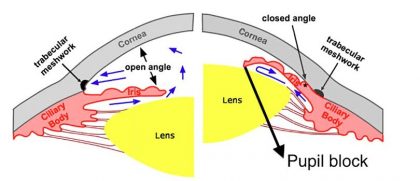Glaucoma
At Eye Doctor, MD, P.C, we provide professional eye care to the communities of Glen Allen, Richmond, and the surrounding areas. Our board certified and fellowship trained ophthalmologist and cornea specialist, Dr. Shilpi Pradhan, ensures that our patients receive the most effective care, utilizing state-of-the art treatment methods and a compassionate, individual-focused approach. For patients that suffer from Glaucoma and are searching for treatment with an eye specialist, look no further than Eye Doctor, MD, P.C.
What Is Glaucoma?
Glaucoma is optic nerve damage due to high eye pressure for you (each individual is different and what qualifies as high differs for each individual). Lowering of intraocular pressure (IOP) is vital to glaucoma treatment. There are other risk factors as well. IOP levels vary during a 24-hr period and with position. Higher fluctuation and higher peak IOP is correlated with worsening vision loss.
How Does The Eye Doctor Monitor Glaucoma?
An ophthalmologist conducts a complete eye exam including intraocular pressure, gonioscopy, pachymetry, optic nerve appearance and clinical testing such as OCT (optical coherence tomography) and visual field testing.
Your eye doctor will also monitor all measurements over time to check for progression of disease.
What Are The Types Of Glaucoma?
There are many types of glaucoma. The two main types include primary open angle glaucoma and angle closure or narrow angle glaucoma. Other types of glaucoma include: congenital, traumatic, pseudoexfoliation, and pigmentary/pigment dispersion syndrome.
What Are The Risk Factors For Primary Open Angle Glaucoma (POAG)?
The main risk factors for primary open angle glaucoma are age, race, and genetics. The risk for glaucoma increases with age in everyone. Certain races are more prone to develop glaucoma. There is some association with glaucoma and smoking, diabetes, sleep apnea, and chronic steroid use. If you have a family history of glaucoma, it is important to have your eyes checked on a regular basis with an eye specialist.
What Are The Risk Factors For Narrow Angle Or Angle Closure Glaucoma (Nag Or Acg)?
Narrow angle glaucoma develops from an anatomical predisposition based on the shape of your eyes. There are certain drugs that precipitate an angle closure attack, which if untreated, can lead to permanent vision loss. The symptoms and signs of an angle closure attack include headache, pain in the eye, pain around the eye, red eye, dilated pupil, nausea, vomiting, sudden blurry vision or loss of vision. If you have these symptoms, contact your eye doctor immediately or go to the nearest emergency room. There is a rare subset of narrow angle glaucoma patients who may have plateau iris syndrome where the eye remains narrow even after treatment for narrow angles and may require additional treatment with an ophthalmologist.

Figure from Qatar Med J. 2015; 2015(1): 6.
What Is The Treatment For Glaucoma?
Read Dr. Pradhan’s Blog post about glaucoma treatments.
Take the Eye-Q test. See how much you know about Glaucoma.
What is Glaucoma? EyeSmart Website
What is Glaucoma? NIH Website
What is Glaucoma? Prevent Blindness America
Glaucoma Treatment – Eyesmart Website
Narrow Angle Glaucoma – YouTube Video
Contact Eye Doctor MD, P.C. Today!
For any questions about Glaucoma, or to schedule an appointment with Dr. Pradhan at our local eye center, just contact us to receive assistance from a member of our staff. We also offer a wide range of other eye care procedures including dry eye disease treatment, cornea treatment, cataract surgery, IPL (intense pulse light) therapy, and more, providing everything you need for healthy vision all in one place. We look forward to providing you with the professional eye care that you deserve.
